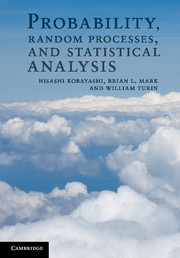 Probability, Random Processes, and Statistical Analysis
Probability, Random Processes, and Statistical Analysis from Part II - Transform methods, bounds, and limits
Published online by Cambridge University Press: 05 June 2012
In addition to the moment generating function (MGF) and characteristic function (CF) methods discussed in the preceding chapter, there are two other related methods that are frequently used in the study of probability theory. They are the generating function and the Laplace transform (LT).
Discrete RVs often assume integers or integral multiples of some unit, as is the case in counting applications and discrete-time systems. Then, the generating function method will be found to be a convenient device in probability analysis. When a random variable is continuous but nonnegative (e.g., waiting time and service time in a queueing system), we can make use of the rich theory of LTs in the analysis.
Since the CF exists for all distribution functions, both discrete and continuous, why should we study all these other transform methods that seem redundant? Certainly the CF should suffice in most situations, but generating functions and LTs are preferred whenever they are applicable, partly because their notation is somewhat simpler than that of the CF, and partly because there is a rich theory behind the generating function and LT methods, both of which have been widely used as operational methods in system theory that involves differential and integral equations. Thus, it is important for us to be sufficiently familiar with these transform methods to study the literature on probability theory and its applications.
Generating function
The notion of generating function can be more general than the probability generating function (PGF) that we will primarily discuss in this section.
To save this book to your Kindle, first ensure [email protected] is added to your Approved Personal Document E-mail List under your Personal Document Settings on the Manage Your Content and Devices page of your Amazon account. Then enter the ‘name’ part of your Kindle email address below. Find out more about saving to your Kindle.
Note you can select to save to either the @free.kindle.com or @kindle.com variations. ‘@free.kindle.com’ emails are free but can only be saved to your device when it is connected to wi-fi. ‘@kindle.com’ emails can be delivered even when you are not connected to wi-fi, but note that service fees apply.
Find out more about the Kindle Personal Document Service.
To save content items to your account, please confirm that you agree to abide by our usage policies. If this is the first time you use this feature, you will be asked to authorise Cambridge Core to connect with your account. Find out more about saving content to Dropbox.
To save content items to your account, please confirm that you agree to abide by our usage policies. If this is the first time you use this feature, you will be asked to authorise Cambridge Core to connect with your account. Find out more about saving content to Google Drive.